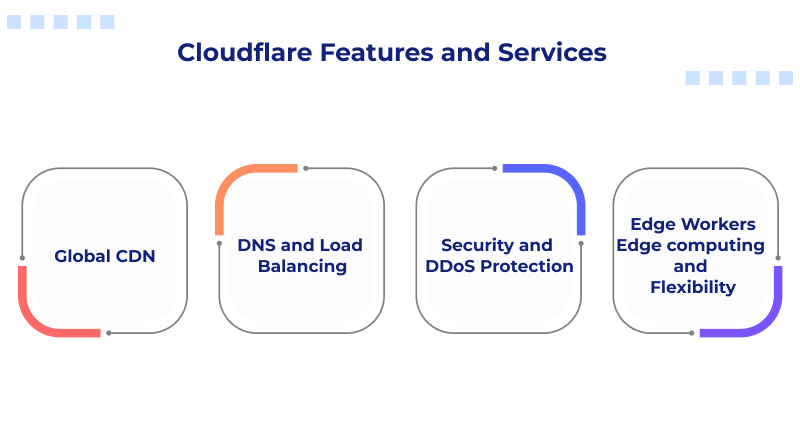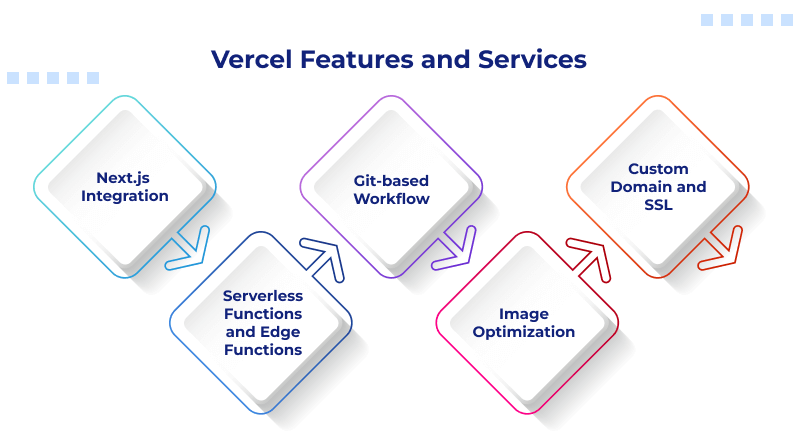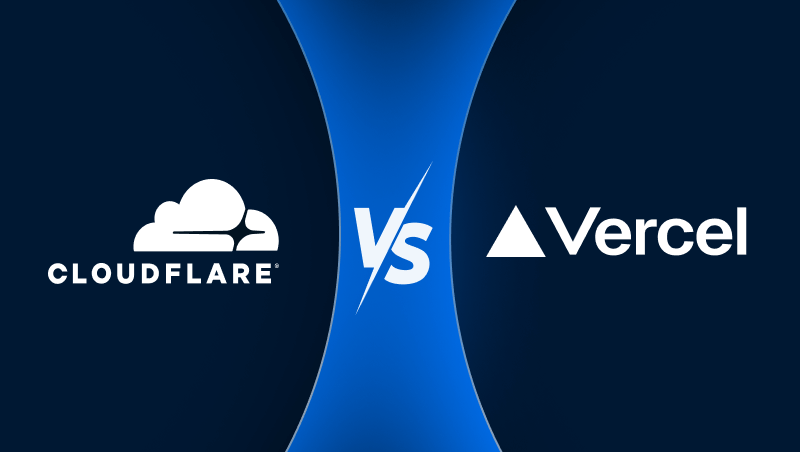The performance, security, and scalability of different types of web applications determine an online business’s success. Cloudflare is a renowned global CDN, with advanced security features and edge computing solutions. At the same time, Vercel is the go-to choice for developers seeking seamless deployment on the best Node.js frameworks.
Table Of Content
In this blog, we have explored the key differences between Cloudflare and Vercel. Which IT asset is user-friendly? Find out!
What is Cloudflare?
Cloudflare is an American company offering premium CDN services. CDN (Content Delivery Network) distributes content across its global network to speed up loading times and provide advanced DDoS protection. It was founded in 2009, and since then, it has evolved into a global network with 285 data centers. It is the largest CDN provider worldwide.
Cloudflare Features and Services

- Global CDN: Cloudflare’s vast network allows developers to serve content quickly. Regardless of the user’s location, caching assets at the edge makes content delivery easier.
- DNS and Load Balancing: With Cloudflare, you get the load-balancing capabilities. Load balancing is possible because of the built-in DNS service. It ensures websites stay online during traffic spikes.
- Security and DDoS Protection: Cloudflare protects the web assets with intensive security. It encompasses WAF, bot protection, and protection against DDoS attacks.
- Edge Workers Edge computing: Cloudflare Workers is a serverless computing platform that allows developers to execute their code on the edge of Cloudflare, lowering latency and granting more precise control over the processing of requests.
What is Vercel?
Vercel is a dedicated cloud provider that deals with the deployment and frontend of applications. It uses applications that are based on the best JavaScript frameworks. Velcel was created in 2025 and has attracted the attention of the developer community. It is famous due to its simplicity, rapidity, and a strong connection with Next.js, a popular React-based framework created by Vercel. Vercel is highly praised for its efficient workflow, which enables pushing a commit and deploying it anywhere globally, and for prioritizing a seamless developer experience.
Vercel Features and Services

- Next.js Integration: Vercel’s deep integration with Next.js allows it to offer unique features.
- Serverless Functions and Edge Functions: Vercel provides serverless and edge functions that allow developers to run backend code without managing infrastructure. Serverless and edge functions work well with Vercel’s frontend development focus, enabling developers to deploy complete full-stack applications.
- Git-based Workflow: It’s worth noting that Vercel’s deployment workflow is tightly integrated with GitHub, GitLab, and Bitbucket, enabling a continuous deployment process and providing a preview environment for every branch.
- Image Optimization: Built-in support for image optimization functionality is available for any applications with a critical performance component tied to loading a page.
- Custom Domain and SSL: Vercel has built-in support for custom domains, which simplifies the process of securing a domain with an SSL certificate, receiving automatic renewal.
Web Hosting: Cloudflare vs Vercel
1. Performance and Speed
Cloudflare utilizes a giant global Content Delivery Network (CDN) that improves the speed of websites by distributing content nearer to its visitors. Vercel is a frontend-oriented performance optimization tool that offers features such as edge caching and instant rollbacks. It is a great option among developers who create dynamic, high-responsive applications.
2. Security and Protection
Cloudflare is renowned for having an advanced security stack. It provides WAF, bot management, and DDoS protection. Vercel, on the other hand, lacks an SSL certificate and built-in safeguards. It is also not a security-first service, such as Cloudflare, so companies that have highly sensitive security needs frequently overlay Cloudflare on top of Vercel deployments.
3. Developer Experience
Vercel offers a straightforward developer experience, featuring automatic builds, serverless functions, and framework-specific integrations. In contrast, Cloudflare provides support for both Workers and Pages, but is generally considered more developer-friendly due to its simplicity and straightforward deployment process.
4. Scalability and Use Cases
Cloudflare’s globally scalable infrastructure makes it an appropriate solution for companies and organizations that value high availability, compliance, and the web hosting infrastructure. Vercel is easy to scale frontend applications and is used by startups, SaaS products, and teams operating in a fast-paced, fast-iteration, and delivery cycle.
Cloudflare vs Vercel: Pricing
Cloudflare Pricing
| Plan | Description | Pricing | Billing Details |
| Free | For personal or hobby projects that aren’t business-critical. | $0/month | Add-ons billed monthly |
| Pro | For professional websites that aren’t business-critical. | $20/month | When billed annually or $25/mo billed monthly |
| Business | For small businesses operating online. | $200/month | When billed annually or $250/mo billed monthly |
| Contract | For mission-critical applications that are core to your business. | Custom | Billed annually |
Vercel Pricing
| Resource | Included | Additional |
| ISR Writes | First 2,000,000 | 1,000,000 Write Units for $4.00 – $6.40 |
| ISR Reads | First 10,000,000 | 1,000,000 Read Units for $0.40 – $0.64 |
| Fast Data Transfer | First 1 TB | 1 GB for $0.15 – $0.35 |
| Fast Origin Transfer | First 100 GB | 1 GB for $0.06 – $0.43 |
| Edge Requests | First 10,000,000 | 1,000,000 Requests for $2.00 – $3.20 |
| Edge Request Additional CPU Duration | 1 Hour | 1 Hour for $0.30 – $0.48 |
| Image Optimization Transformations | 10K/month | $0.05 – $0.0812 per 1K |
| Image Optimization Cache Reads | 600K/month | $0.40 – $0.64 per 1M |
| Image Optimization Cache Writes | 200K/month | $4.00 – $6.40 per 1M |
| Runtime Cache Writes | First 2,000,000 | 1,000,000 Write Units for $4.00 – $6.40 |
| Runtime Cache Reads | First 10,000,000 | 1,000,000 Read Units for $0.40 – $0.64 |
| WAF Rate Limiting | First 1,000,000 Allowed Requests | 1,000,000 Allowed Requests for $0.50 – $0.80 |
| OWASP CRS per request number | N/A | 1,000,000 Inspected Requests for $0.80 – $1.28 |
| OWASP CRS per request size | 4KB of each inspected request | 1 GB of inspected request payload for $0.20 – $0.32 |
| Blob Storage Size | First 5 GB | 1 GB for $0.02 – $0.04 |
| Blob Simple Operations | First 100,000 | 1,000,000 for $0.35 – $0.56 |
| Blob Advanced Operations | First 10,000 | 1,000,000 for $4.50 – $7.00 |
| Blob Data Transfer | First 100 GB | 1 GB for $0.05 – $0.12 |
The web development evolution has made security, performance, and scalability non-negotiable by choosing a deployment platform that natively integrates with Cloudflare, moving beyond web hosting, and embracing a modern, serverless architecture.
Not that we have a managed platform at our disposal, there are several advantages of this approach: your Next.js application is no longer bound to a single data center, but is actually deployed as code on Cloudflare’s global network. You get unbelievably low latency and high availability, which means you will be able to provide your users with a consistently fast experience, no matter where they are located.
Additionally, this type of deployment means you will have access to all of Cloudflare’s developer products, from serverless databases like D1 to cheaper object storage with R2. This unified experience will not only simplify your deployment but also open the doors to new ways to build full-stack applications at the edge.
FAQs
1. Why is Vercel considered a “developer experience” platform?
Vercel is a developer experience platform because it streamlines the process of building, deploying, and scaling web applications, allowing developers to focus solely on coding with features like zero-configuration deployments and instant previews.
2. Why is Cloudflare considered a “web infrastructure” platform?
Cloudflare is a web infrastructure platform because it provides a comprehensive suite of services that sit at the core of the internet to improve the performance, security, and reliability of websites and applications.
3. What are the key differences between Cloudflare Workers and Vercel Edge Functions?
Cloudflare Workers are a low-level, flexible serverless platform, while Vercel Edge Functions are a high-level abstraction built on top of Workers, tightly integrated with the Vercel ecosystem for frontend-centric use cases.
4. Which platform is more cost-effective for a growing project?
Cloudflare is often more cost-effective for a growing project because its pricing is more predictable with transparent, low-cost usage-based billing. In contrast, Vercel’s overage fees can become significant and harder to predict.
5. Are there any hidden costs I should be aware of when using either platform?
The primary hidden costs on Vercel are overage fees for exceeding resource limits, while on Cloudflare, hidden costs can come from tiered services with separate pricing and rounding of billable units for products like R2 storage.















